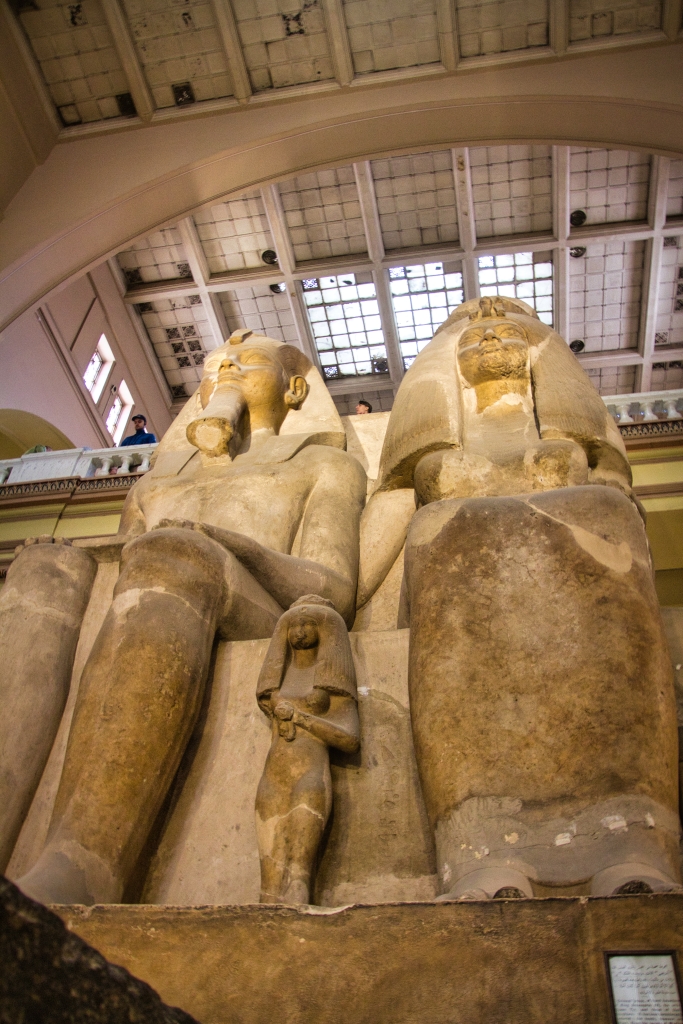
Photo by Galen C. Dalrymple, copyright 2024. All Rights Reserved.
Today’s image is one I shot of the view at the far end of the entry hallway at the Egyptian Museum in Cairo. This colossal statue depicts the royal couple, Amenhotep III and his wife Tiye, along with their three daughters. This is the largest known ancient Egyptian family group statue ever carved, and it is fitting that it dates to the reign of Amenhotep III, whose prosperous rule was marked by great such monumentality.
Amenhotep III was dubbed “The Magnificent” in the 14th century BC. He brought unprecedented amounts of gold to his kingdom, built temples and statues, including the famous Colossi of Memnon and many religious buildings, and portrayed his wife, Queen Tiye, in an unprecedented egalitarian manner.
Amenhotep was part of the 18th dynasty and reigned from approximately 1390–1352 BC. Of particular interest in this image is the fact that Tiye is carved to be the same size as the pharaoh, indicating that they were both of equal power and importance. Another interesting thing about this monumental statue is the way Tiye has her right arm around Amenhotep’s back.
Amenhotep III was the son of Thutmose by a minor wife Mutemwiya. His reign was a period of unprecedented prosperity and artistic splendor, when Egypt reached the peak of its artistic and international power. When he died in the 38th or 39th year of his reign, his son initially ruled as Amenhotep IV, but then changed his own royal name to Akhenaten.
ON THIS DAY IN HISTORY: in 2015, Harlem Hellfighter Henry Johnson was awarded a posthumous Medal of Honor. The medal came after a decades-long effort by Johnson’s family and New York Senator Chuck Schumer to recognize Johnson’s bravery and service during World War I.
Henry Johnson, a railroad porter from Albany, New York, enlisted in the army in 1917, after America’s entry into the war in Europe. He joined an all-Black National Guard unit, which became the all-Black 369th Infantry Regiment of the American Expeditionary Force. General John J. Pershing sent the regiment to serve under French command in 1918, in order to preserve the racial segregation of the American army, which then deployed Black regiments only for menial support roles.
The soldiers of the 369th, many of whom came from Harlem, earned the nickname the “Harlem Hellfighters” for their valor in battle. They spent 191 days on the front lines, the longest stretch of active combat of any comparable regiment during the war; as a result, they also sustained more casualties than any other regiment. Some 171 members of the 369th received the prestigious French military honor, the Croix de Guerre.
Private Henry Johnson and Private Needham Roberts were assigned to night sentry duty on May 15, 1918, in the Argonne Forest between the French and German lines. When a German raiding party attacked, Roberts was badly wounded, and Johnson was left to single-handedly fight off a dozen or more German soldiers. He threw grenades and fired at them with his rifle before resorting to hand-to-hand combat, using only the butt of his rifle and a bolo knife for weapons. By the time French reinforcements arrived an hour later, Johnson had been wounded 21 times. However, he had killed several Germans and wounded up to a dozen more. He had preserved the French line from a German incursion and prevented the capture of his fellow soldier.
For his extraordinary bravery, France quickly awarded Johnson with the Croix de Guerre, the nation’s highest award for valor. At home in the United States, he earned the nickname “the Black Death.” One reporter even called the events of May 15 “the battle of Henry Johnson.” After the war, Johnson starred in the 369th regiment’s victory parade down Fifth Avenue in Manhattan, and he featured on commemorative stamps and army recruitment materials. However, Johnson never received disability pay from the army. He returned to his job as a railroad porter in Albany, struggling with his extensive war injuries. Johnson eventually died in poverty at age 32, in 1929.
In the 1990s, Johnson’s son, Herman Johnson, began lobbying for his father to receive posthumous military honors. Herman Johnson was a veteran himself, having served as a Tuskegee Airman in World War II. President Bill Clinton awarded Henry Johnson the Purple Heart in 1996. Senator Chuck Schumer took up Johnson’s cause, and in 2002 the US Army awarded Johnson the Distinguished Service Cross, the branch’s second-highest honor. Schumer’s staff unearthed documents which bolstered Johnson’s case, including a memo from General Pershing praising his heroism and an eyewitness account of the attack from Private Roberts. Finally, on June 2nd, 2015, President Barack Obama awarded Henry Johnson the posthumous Medal of Honor, America’s highest military award for valor. – The History Channel
TRIVIA FOR TODAY: The Wizard of Oz’s Full Name is Oscar Zoroaster Phadrig Isaac Norman Henkel Emmannuel Ambroise Diggs. In the book, he explains that he called “myself O.Z., because the other initials were P-I-N-H-E-A-D.”